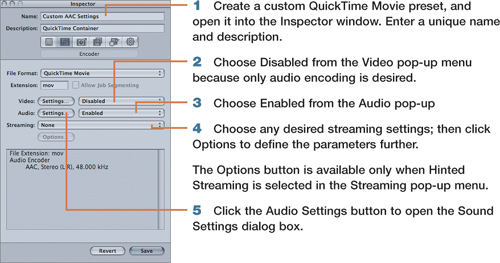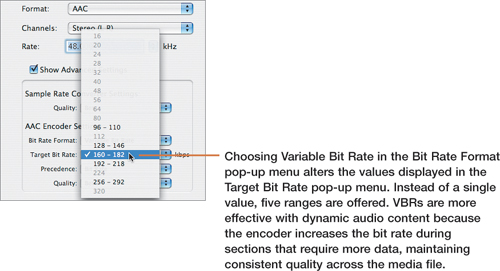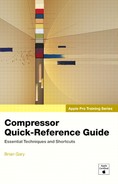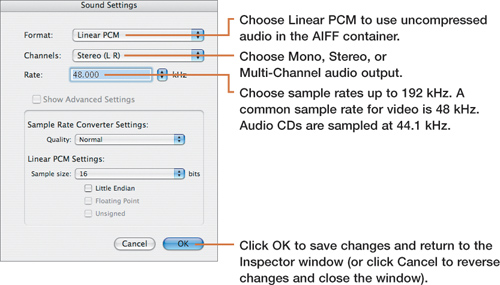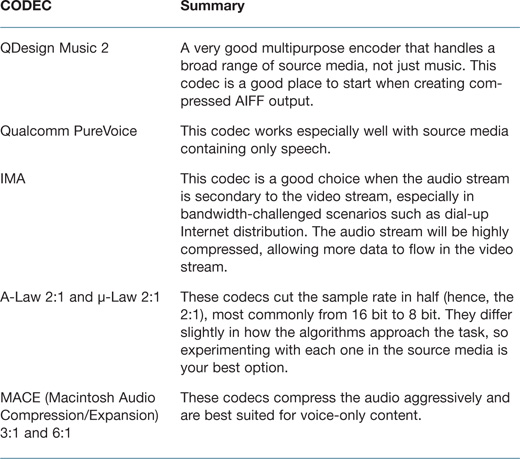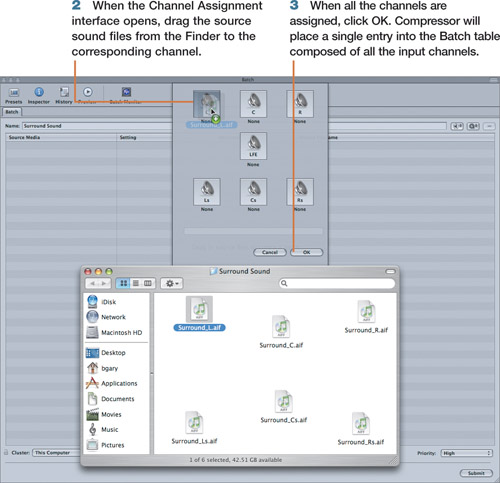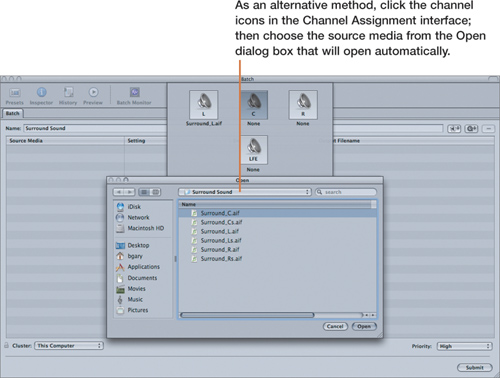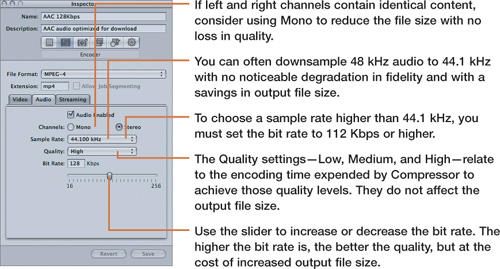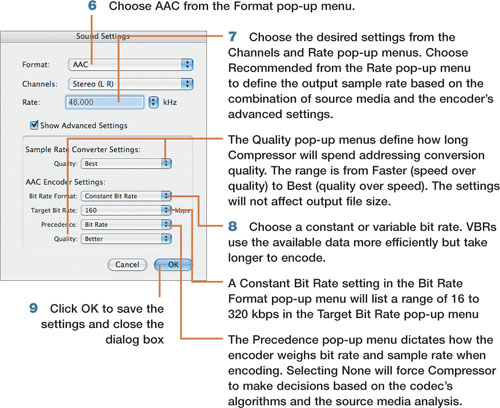6. Encoding Audio
In addition to encoding video, Compressor offers multiple options for encoding audio in multiple formats, from stand-alone CD tracks to 5.1 Dolby Digital audio streams for DVD.
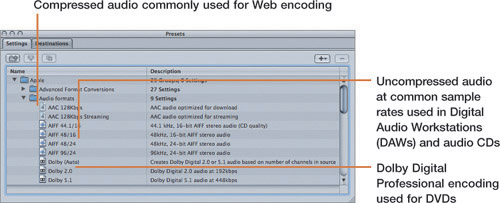
Using AIFF Containers
The easiest way to manage audio in Compressor is to use Audio Interchange File Format (AIFF) presets. AIFF is a container, not an encoder; AIFF is not a codec, but a format that lets computers interact with digital audio data.
Compressor does allow AIFF files to include codecs, but the audio is most commonly stored uncompressed as a Linear Pulse Code Modulation (PCM) stream. Linear PCM is a digital representation of analog signals. Most DAWs use Linear PCM in WAV, SDII (Sound Designer II), or AIFF containers. Apple developed AIFF, and it is widely used on the Mac for professional, high-quality audio content.
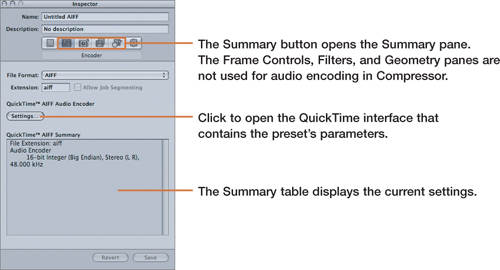
An AIFF preset loaded into the Inspector window.
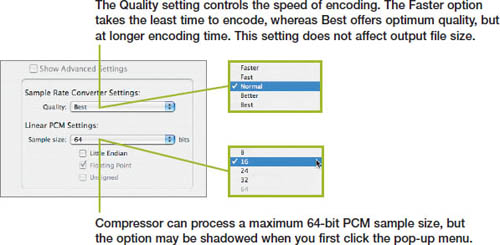
The higher the sample and bit-rate settings are, the higher the resulting quality, but at the cost of increasing output file sizes.

Using AIFF for DVD Assets
The DVD specification allows all audio content to exist as uncompressed PCM streams in AIFF containers or as streams encoded with Dolby Digital. The simplest option is to encode elementary audio streams using the AIFF audio preset.
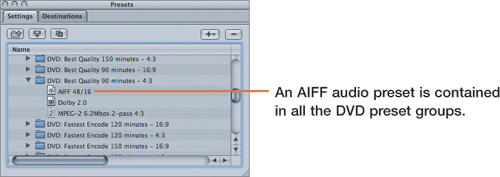
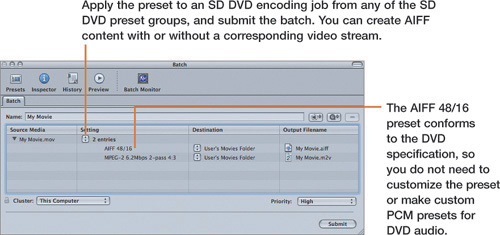
This example properly separates the DVD content into elementary streams of audio and video, and will produce media with filenames consistent with easy DVD Studio Pro importation.
Converting Sample Rates Using AIFF
Another common use of the AIFF 48/16 stock preset converts the sample rate of audio to a standard sample rate for digital video: 48 kHz at 16-bit.
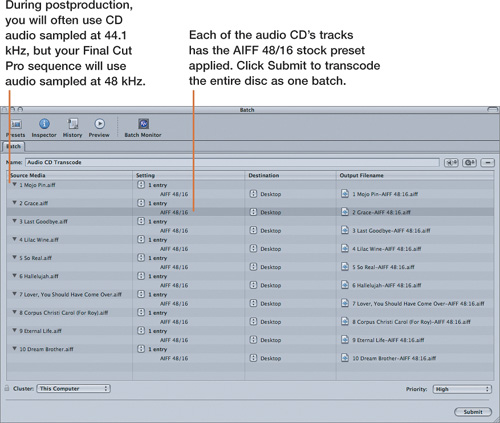
This preset requires no customization to work as described. You can apply the preset to an entire disc by setting up a batch
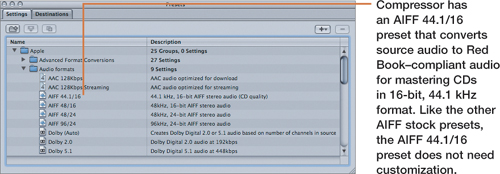
AIFF Presets Containing Codecs
Although the most common form of AIFF encoding uses uncompressed audio, you can easily create custom presets that include encoders within the AIFF container.

Open the custom preset in the Inspector window; then give it a name and description based on your custom settings. In the Encoder pane click the Settings button to modify the audio parameters.
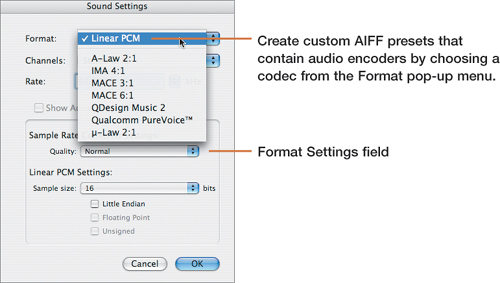
Choosing different codecs from the Format pop-up menu will change the available options in the Format Settings field.
Various audio codecs are preferable for specific output scenarios, as shown in this table:
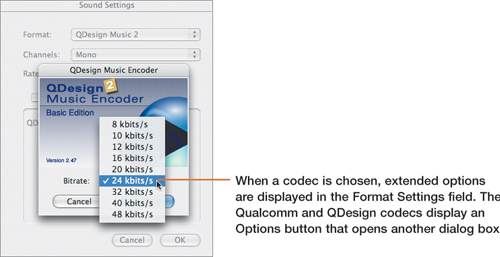
Encoding with Dolby Digital Professional
In all the DVD preset groups (SD and HD), a Dolby 2.0 preset is available for encoding stereo (left and right channel) audio into DVD-compliant AC3 elementary streams. Dolby encoding is highly efficient and can save a considerable amount of disc space with no noticeable loss in quality compared with uncompressed Linear PCM streams.
Note
The Dolby Digital Professional encoder is installed only on systems on which either Final Cut Studio or DVD Studio Pro was installed along with Compressor.
The stock Dolby 2.0 preset requires very little user customization to produce great-sounding, low-bandwidth audio streams. In the Inspector window, the Dolby Digital Professional preset is organized into three tabs:
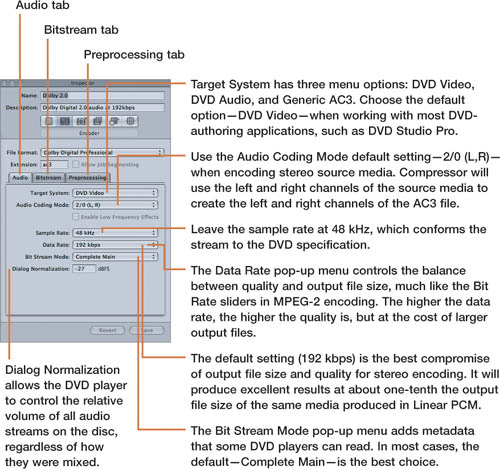
If your main movie was edited in Final Cut Pro with audio mixed at –12 decibels (dB), and you have commentary tracks mixed at –27 dB, you can have the DVD player adjust the volumes of the tracks so they sound as if they were mixed at the same levels. In the Dialog Normalization field, enter the average volume of the source media relative to full modulation for each audio stream. If all source media files were mixed identically, it is best to turn off Dialog Normalization by entering a value of –31 dB, rather than enter the same value for each stream.
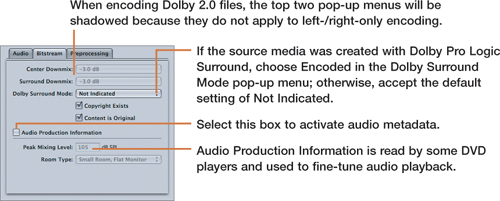

Creating Dolby 5.1 Surround Sound Assets
Creating a surround-sound mix is a five-step process, but Compressor is involved in only the final two steps:
1. Record audio on a sound stage or in a recording studio.
2. Mix down the audio into separate audio channels that locate the sounds in surround space so that the audience actively experiences the aural environment.
3. Digitize the audio into 48 kHz audio files (AIFF, QuickTime, or WAV).
4. Identify the channel placement for DVD playback in 5.1 Surround Sound.
5. Encode the source media into a single AC3 file that a DVD player will decode as 5.1 Surround Sound.
The first three steps require a considerable amount of hardware and software, but after the resulting source media files are created, follow these steps to produce a 5.1 Surround Sound AC3 file for your DVD project:
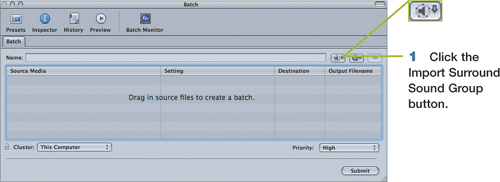
If you need to edit any of the channels, select the Surround Sound entry in the Batch table to open the Channel Assignment interface in the Inspector window.
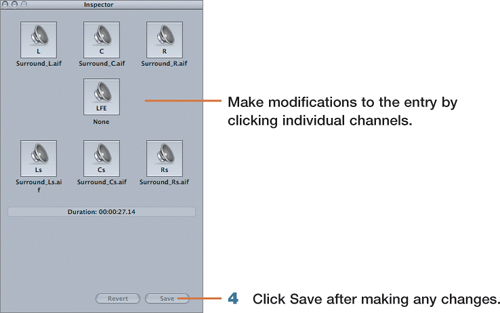
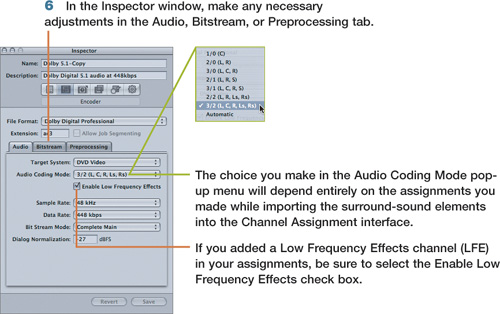
After all of the assignments and modifications are complete send the job for encoding by clicking the Submit button in the Batch window.
Encoding Audio Using AAC
AAC (Advanced Audio Coding) is a high-quality codec that produces audio fidelity comparable to the ubiquitous MP3 codec with smaller output files or superior quality at the same output file size. Apple’s iTunes media player uses 128 Kbps AAC encoding as the default rate for importing (ripping) audio from CDs. AAC also adds variable-bit-rate (VBR) encoding to audio compression. AAC is a perceptual codec, meaning that it throws away audio information that it deems less important to reduce file size, but still maintain perceived quality.
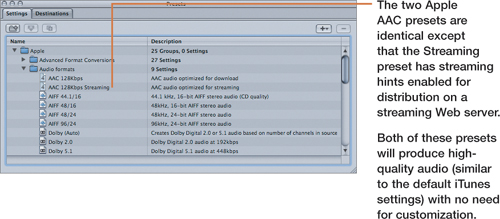
Custom AAC Presets Using MPEG-4
The easiest way to create a custom AAC preset with MPEG-4 as the file format is to duplicate one of the existing Apple presets.
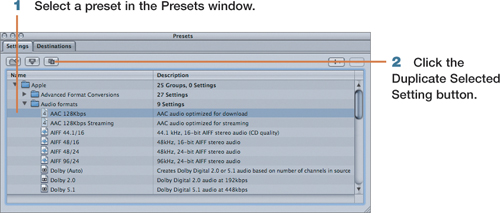
This example will create a custom AAC preset in the Custom folder.
Custom AAC Presets Using AIFF
You can also create AAC presets by defining custom QuickTime movie presets in the Presets window. Custom QuickTime presets in the Inspector window display a different interface from MPEG-4 presets, but the core AAC encoding concepts are similar. One significant advantage to using AIFF over MPEG-4 is the option for VBR encoding.
